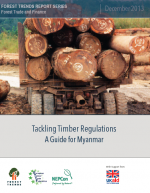Tackling Timber Regulations
A Guide for Myanmar
View PublicationOver the past decade, several major timber product consumer countries have put into place new regulations aimed at curtailing the import of illegally sourced wood products. The United States pioneered this development by passing an amendment to the Lacey act in 2008. This move was followed by the EU, which approved the EU Timber Regulation 2010. Subsequently, the Australian Illegal Logging Prohibition Act was made official in November 2012. Illegal logging, as defined in these three regulations, is the harvesting of timber in contravention of the laws and regulations of the country of harvest.
The main requirements of these regulations can be summarized as follows: 1) There is a ban on placing illegal timber on the market; 2) There is a requirement for due diligence, including calls for importers to: a) Provide access to information about the origin and legality of the material
b) Conduct risk assessment of the risk that material is originating from illegal sources; c) Mitigate any significant risks.
These three new timber trade laws in Australia and the US have been changing the timber markets, providing challenges to timber exporting countries such as Myanmar. The new laws restrict the trade in illegally harvested timber and place obligations on the importers to these regulated markets. To remain effective in the international timber markets and ensure market access for the export industry, it is important to understand these new regulations and be able to provide timber with the necessary legality assurance.
This guide provides an overview of the key aspects of these regulations and offers suggestions for how the Myanmar government and timber industry can improve market access by increasing the level of legal timber assurance.

